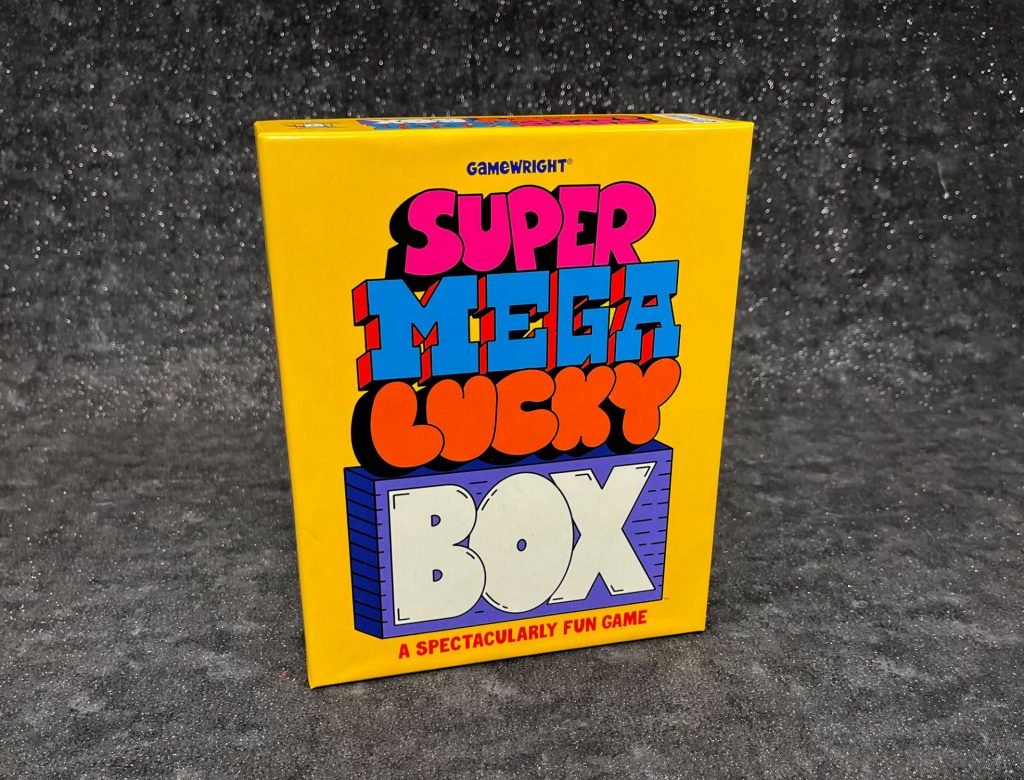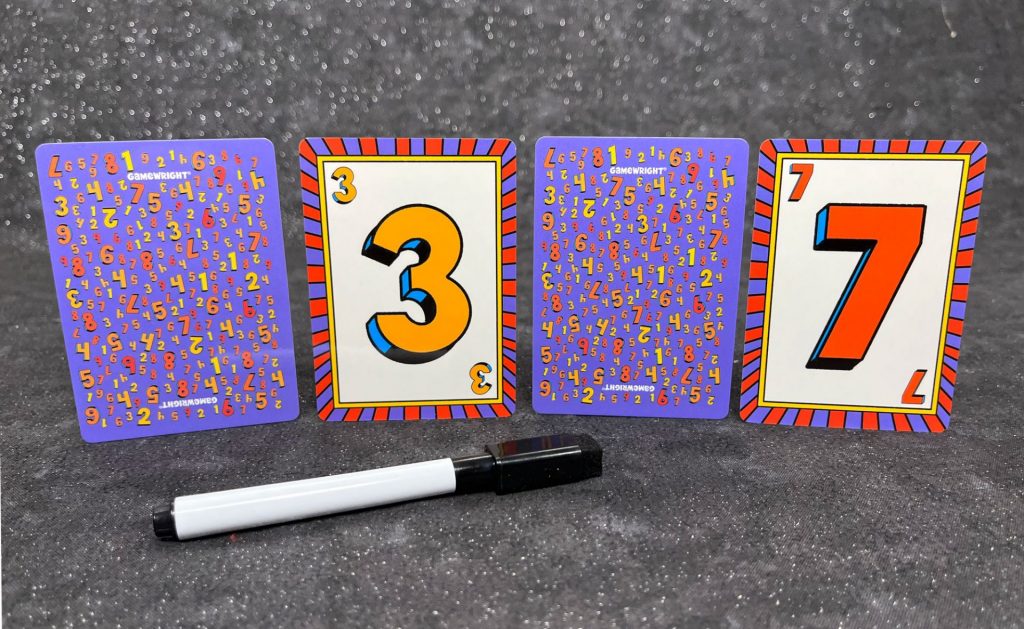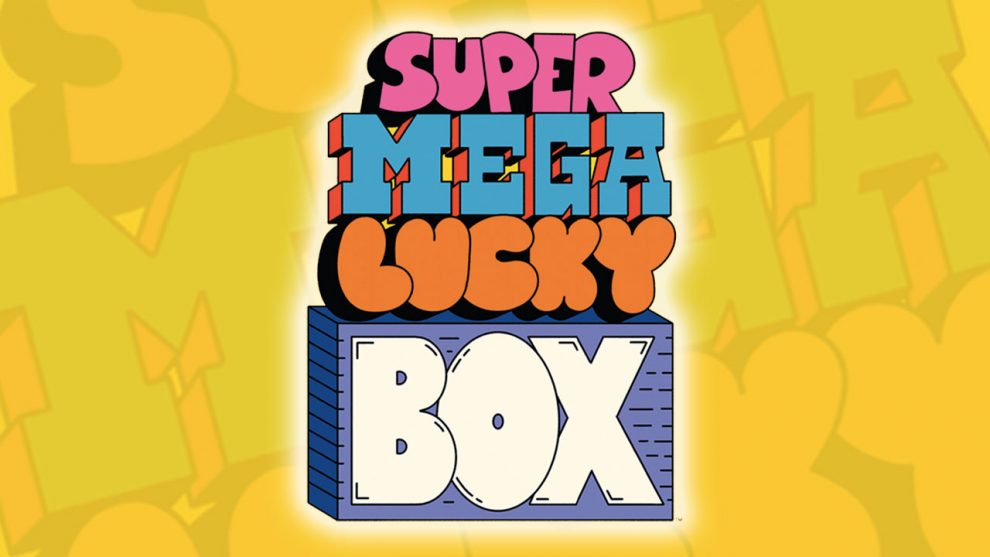Super Mega Lucky Box, the newest title from cardboard wizard and official fun-time master of ceremonies Phil Walker-Harding, is a lightweight “flip and fill” game from Gamewright Games. I love lightweight games myself, in fact I occasionally blaspheme the board game gods by claiming that light games are actually more challenging to design than heavier and more complex games. You can always add more rules, and make things more complex, but it takes a master to make a well thought out game from just a handful of rules. While Super Mega Lucky Box certainly isn’t a masterpiece, it does entertain. Let me tell you about it.

Super Mega Lucky Box Overview
In Super Mega Lucky Box you are trying to gain the most points by filling in your “lucky box” cards, earning points for completed cards as well as bonuses for finishing rows and columns. You’ll start the game with 3 lucky box cards and will gain more of them over the course of 4 rounds.

During each round you’ll earn points by flipping over numbered cards from a shared deck.

As each card is revealed each player will cross off a single large number on any one of their lucky box cards. If you complete a row or column you’ll earn the bonus displayed to the right or at the bottom. Bonuses come in one of 5 types
- Numbers – Mark off the indicated number on one of your cards.
- Question mark – Cross off any number on one of your cards.
- Lightning bolts – Collect the indicated number of lightning bolts tokens. These tokens can be used to adjust the value of one of the flipped over cards. One lightning bolt can turn a 4 into a 5, or a 1 into a 9. This change does not affect the number for other players.
- Stars – Collect starts to score bonus points at the end of the game based on a sliding scale. 1 star earns 1 point, while 3 stars will earn 9 points.
- Moons – Collect the indicated number of moon tokens. At the end of the game the player with the most moon tokens will earn 6 points, while the player with the fewest moon tokens will lose 6 points.

The number card deck contains 18 cards (2 each of numbers 1-9), but only 9 cards are used each round. A round ends when the 9th card is flipped over. You’ll score (then discard) all your completed lucky box cards using the provided score card. Draw new lucky box cards, shuffle the number card deck, then start the next round.
After the 4th round, tally up your points from completed lucky box cards, stars, earn 1 point for every 2 crossed out boxes on all your active lucky box cards, then determine who earns and loses points for moon tokens. The player with the most points wins.
Thoughts on Super Mega Lucky Box
Phil Walker-Harding has designed some of my favorite games: Imhotep, Cacao, Barenpark, Silver & Gold, and Sushi Go. The past year or two has been kind to Phil because he released an eye-popping 11 games in 2021. And he’s already got titles lined up for 2022 as well.
So let’s talk Super Mega Lucky Box. As a child of the 70s the first thing that caught my attention was the Schoolhouse Rock style graphic design. Vivid yellows, oranges, and pinks, with block and balloon shaped letters just this side of juvenile. I wanted to find out more before I even knew a thing about the game. And when I finally did I was hooked. Super Mega Lucky Box lives at the intersection of Sushi Go, Silver & Gold, Bingo, and Ganz schon clever, yet manages to be its own game.

As I mentioned earlier, this is very light, with not much in the way of strategy, but with clever gameplay you can juice the luck factor and make it work in your favor. You start with 3 cards, selected from a draw pile of 5. Because the number cards are shuffled you never know what you’re going to get, so make sure your starting 3 cards have a wide range of digits. Also try to select cards with lightning bolt bonus squares early on. The sooner you get those, the easier the rest of the game will be. In some of our plays there were multiple turns in a row where neither myself or my opponents could cross off anything so being able to affect the outcome of a flip is big. And even though “luck” is literally in the name of the game, that still stung a bit.
In my plays, scores ranged from 18 to 55, so every little bit counts. Don’t forget to pick up moon bonuses whenever possible because that 12 point spread can make a big difference. It’s also worth pointing out that you earn more points for completing cards earlier in the game: 15 points for cards completed in round one versus only 8 points for cards completed in round four. And finally do your best to gain stars every round: 2 stars earned each round would be worth 16 points.
I’m always impressed with Phil’s range of game designs. Imhotep was abstract and thinky, with more than a little “take that” in the way you’d dock the boats. Gizmos is an engine building, eye-catching gumball machine with combos galore. And Sushi Go is the de-facto entry level card drafting game whose scoring framework has influenced dozens and dozens of other games. I think it’s no disservice to either designer to compare Phil to Reiner Knizia, who has designed over 600 games in his 25 year career.
Super Mega Lucky Box probably won’t win any awards, and it’s not my favorite game from Phil Walker-Harding, but it’s worth your time to play, to test your luck and win – or lose for that matter. But even if you lose a game of Super Mega Lucky Box you’ve still come out ahead because you’re spending time with friends and family, and as the past few years have taught us that’s never a sure thing.












Add Comment